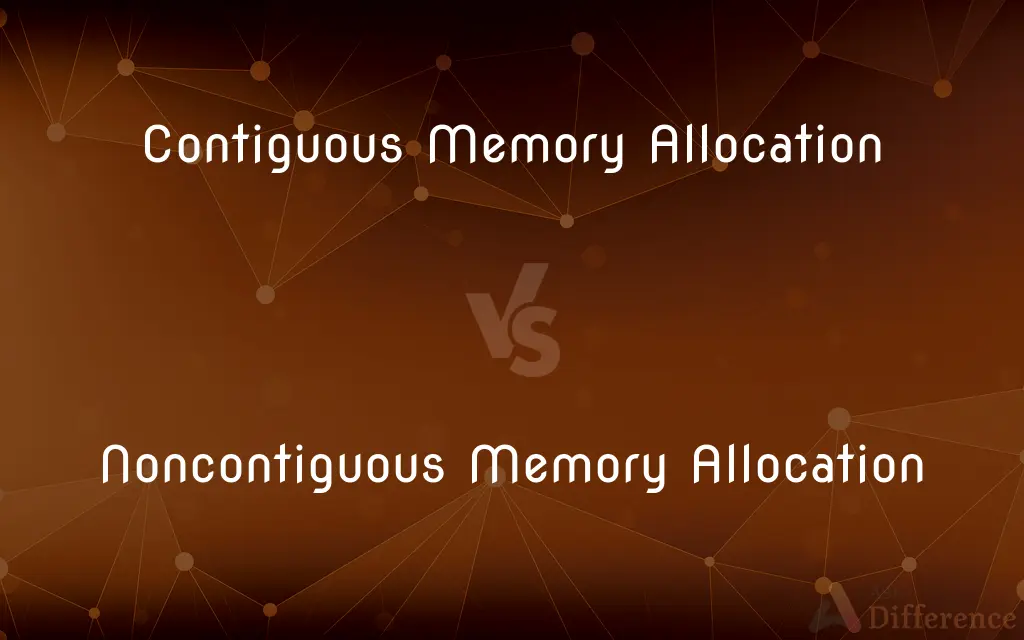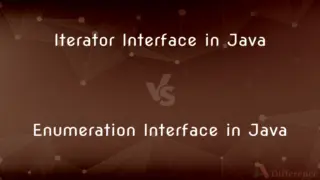Contiguous Memory Allocation vs. Noncontiguous Memory Allocation — What's the Difference?
By Tayyaba Rehman & Urooj Arif — Published on January 31, 2024
Contiguous Memory Allocation stores data in a single, continuous block of memory, while Noncontiguous Memory Allocation uses multiple, separate memory locations.

Difference Between Contiguous Memory Allocation and Noncontiguous Memory Allocation
Table of Contents
ADVERTISEMENT
Key Differences
In Contiguous Memory Allocation, data is stored in one unbroken block of memory. This method simplifies memory access and management but can lead to issues like fragmentation. Noncontiguous Memory Allocation, on the other hand, allows data to be stored in several disjointed memory spaces, making it more flexible and efficient in utilizing memory, but it can complicate memory management and increase overhead.
Contiguous Memory Allocation requires that a single, contiguous section of memory be available for allocation, potentially leading to inefficient memory use. Noncontiguous Memory Allocation allows for more efficient use of memory by using various scattered sections, but it requires more complex memory management techniques.
When using Contiguous Memory Allocation, memory management is simpler as it involves allocating and deallocating single chunks. However, it can lead to problems like external fragmentation. Noncontiguous Memory Allocation, while more complex, overcomes fragmentation by utilizing memory spaces that are not adjacent.
Contiguous Memory Allocation is generally faster in terms of access time since data is stored sequentially. However, it may not be as space-efficient. Noncontiguous Memory Allocation, while offering better space utilization, may have slower access times due to the scattered nature of data storage.
In systems where large blocks of memory are commonly required, Contiguous Memory Allocation might pose limitations. Noncontiguous Memory Allocation is more suitable for such systems as it can efficiently utilize available scattered memory spaces.
ADVERTISEMENT
Comparison Chart
Memory Block Usage
Uses a single continuous block
Uses multiple, separate blocks
Fragmentation
Prone to fragmentation
Reduces fragmentation issues
Memory Management Complexity
Simpler management
More complex management
Space Efficiency
Less space-efficient
More space-efficient
Suitability for Large Data Blocks
Less suitable
More suitable
Compare with Definitions
Contiguous Memory Allocation
Memory management technique involving continuous memory space.
Contiguous Memory Allocation was used for efficient data access.
Noncontiguous Memory Allocation
Memory management using scattered memory spaces.
To handle dynamic memory needs, Noncontiguous Memory Allocation was employed.
Contiguous Memory Allocation
Sequential storage of data in memory.
For quick retrieval, Contiguous Memory Allocation was preferred.
Noncontiguous Memory Allocation
Allocation of memory in separate, nonadjacent blocks.
Noncontiguous Memory Allocation was utilized to optimize memory usage.
Contiguous Memory Allocation
Allocation of a single unbroken block of memory.
The program's array was stored using Contiguous Memory Allocation.
Noncontiguous Memory Allocation
Discontinuous allocation of memory space.
Due to memory constraints, Noncontiguous Memory Allocation was necessary.
Contiguous Memory Allocation
A method where memory is allocated in one contiguous segment.
Contiguous Memory Allocation simplified the program's structure.
Noncontiguous Memory Allocation
A technique of allocating memory in various separate sections.
Noncontiguous Memory Allocation allowed for better space utilization.
Contiguous Memory Allocation
Memory allocation in an unfragmented block.
To avoid fragmentation, Contiguous Memory Allocation was chosen.
Noncontiguous Memory Allocation
Storing data in multiple disjointed memory segments.
The application's flexibility was enhanced by Noncontiguous Memory Allocation.
Common Curiosities
What is Contiguous Memory Allocation?
It's a method of allocating memory where data is stored in one continuous block.
What is Noncontiguous Memory Allocation?
It involves storing data in multiple, separate memory blocks.
What are the advantages of Noncontiguous Memory Allocation?
It's more flexible and efficient in using memory space, reducing fragmentation.
Is Noncontiguous Memory Allocation more complex to manage?
Yes, due to dealing with multiple disjointed memory sections.
Can Contiguous Memory Allocation lead to wasted space?
Yes, it can cause fragmentation, leading to inefficient use of memory.
What type of systems benefit most from Contiguous Memory Allocation?
Systems that don't require large memory blocks or have ample continuous memory.
Is Noncontiguous Memory Allocation better for dynamic memory needs?
Yes, because it can adapt more effectively to varying memory size requirements.
Why might Noncontiguous Memory Allocation be slower?
Because data is scattered, which can increase access time.
Why is Contiguous Memory Allocation simpler?
Because it deals with one unbroken block of memory, making management straightforward.
Does Contiguous Memory Allocation have an advantage in access speed?
Yes, sequential storage allows for faster data access.
How does Noncontiguous Memory Allocation optimize memory usage?
By utilizing various scattered memory sections, it maximizes available space.
Can Contiguous Memory Allocation cause external fragmentation?
Yes, it's prone to external fragmentation due to its continuous block requirement.
What is a major limitation of Contiguous Memory Allocation?
It may not efficiently utilize memory, especially in systems with varying memory needs.
Are there specific applications where Contiguous Memory Allocation is preferred?
Yes, in applications where data access speed is critical and memory needs are predictable.
How does Noncontiguous Memory Allocation handle large data blocks?
It's more efficient as it can use scattered memory spaces.
Share Your Discovery

Previous Comparison
UMA vs. NUMA
Next Comparison
Iterator Interface in Java vs. Enumeration Interface in JavaAuthor Spotlight
Written by
Tayyaba RehmanTayyaba Rehman is a distinguished writer, currently serving as a primary contributor to askdifference.com. As a researcher in semantics and etymology, Tayyaba's passion for the complexity of languages and their distinctions has found a perfect home on the platform. Tayyaba delves into the intricacies of language, distinguishing between commonly confused words and phrases, thereby providing clarity for readers worldwide.
Co-written by
Urooj ArifUrooj is a skilled content writer at Ask Difference, known for her exceptional ability to simplify complex topics into engaging and informative content. With a passion for research and a flair for clear, concise writing, she consistently delivers articles that resonate with our diverse audience.












































